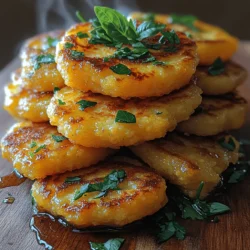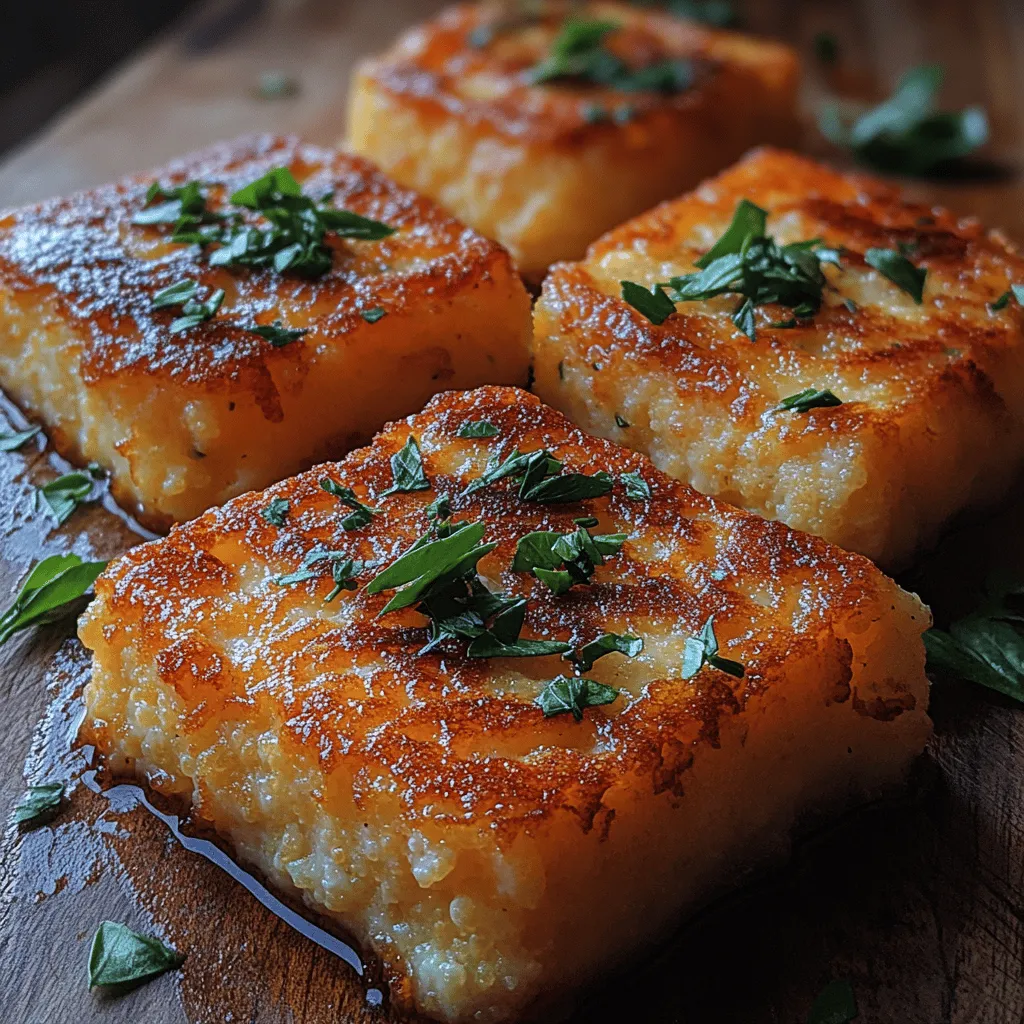Crispy Parmesan Polenta Cakes: A Delightful Culinary Adventure
Polenta, a staple in Italian cuisine, has long been celebrated for its versatility and comforting qualities. Made from ground cornmeal, it serves as a blank canvas for a myriad of flavors and textures, allowing chefs and home cooks alike to unleash their creativity in the kitchen. From creamy polenta served alongside robust sauces to crispy bites that can stand alone or complement a variety of dishes, polenta is an ingredient that deserves a prominent place in every culinary repertoire.
Among the many delightful preparations of polenta, crispy Parmesan polenta cakes stand out for their unique texture and rich flavor. These golden, crispy cakes are not only visually appealing but also deliver a satisfying crunch with every bite. The combination of the creamy polenta base and the addition of Parmesan cheese creates a depth of flavor that is both savory and indulgent. Whether served as an appetizer, a side dish, or even a main course, these polenta cakes are remarkably versatile, pairing beautifully with a range of toppings, from fresh herbs to hearty sauces.
As home cooks, exploring new recipes and ingredients is an essential part of expanding our culinary skills and enhancing our meal offerings. The journey of creating crispy Parmesan polenta cakes not only introduces a delightful dish to your table but also encourages experimentation with flavors and textures that can elevate your cooking experience. In this article, we will delve into the rich history of polenta, break down the essential ingredients, and guide you through the step-by-step cooking instructions to create these delicious cakes.
Understanding Polenta
Polenta is defined as a dish made from boiled cornmeal, and its roots trace back to ancient times in Italy, where it has been a fundamental food for centuries. Traditionally, polenta was made using coarsely ground corn, which was cooked slowly in water or broth to create a thick, creamy consistency. Over the years, polenta has evolved, and today it is enjoyed in various forms, from soft and creamy to firm and crispy, depending on how it is prepared.
There are different types of polenta available, primarily distinguished by the grind of the cornmeal. Coarsely ground polenta, which is often favored for its texture, provides a heartier bite and allows for excellent crisping when fried or baked. On the other hand, finely ground polenta yields a smoother consistency, perfect for creamy side dishes. Choosing the right type of polenta based on your desired outcome is crucial for achieving the perfect texture in your culinary creations.
Beyond its delightful taste and texture, polenta also offers a range of nutritional benefits. It is naturally gluten-free, making it an excellent option for those with gluten sensitivities or celiac disease. Rich in carbohydrates, polenta serves as a significant source of energy, making it an ideal base for a nutritious meal. Additionally, polenta is low in fat, and when prepared with wholesome ingredients, it can be a healthy addition to your diet.
Ingredients Breakdown
To create crispy Parmesan polenta cakes, understanding the role of each ingredient is key to achieving the best flavor and texture. Here’s a detailed breakdown of the essential components of this recipe:
– Coarsely Ground Polenta: The star ingredient, coarsely ground polenta, is prized for its texture and cooking properties. When cooked, it transforms into a creamy base that can be molded and shaped. Its grainy texture also provides the perfect foundation for crispiness when fried.
– Vegetable Broth: Using vegetable broth instead of water enhances the flavor profile of the polenta, infusing it with additional depth and richness. The broth also contributes moisture, ensuring that the polenta remains creamy and delicious.
– Parmesan Cheese: Aged for a minimum of 12 months, Parmesan cheese brings a distinctive nutty and savory flavor to the dish. Its role in the recipe is not only to add taste but also to contribute to the structure of the cakes, helping them hold together when cooked.
– Seasonings (Salt, Black Pepper, Garlic Powder, Onion Powder): These seasonings elevate the overall taste of the polenta cakes. Salt and black pepper provide essential seasoning, while garlic and onion powder add aromatic qualities that deepen the flavor.
– Olive Oil: Essential for frying the polenta cakes, olive oil not only helps achieve a crispy exterior but also adds a rich flavor. It’s important to use a good-quality oil to enhance the overall taste of the dish.
– Fresh Herbs: To finish off the crispy polenta cakes, fresh herbs such as parsley or basil can be used as a garnish. They add a pop of color and a refreshing note that complements the richness of the cakes.
Step-by-Step Cooking Instructions
Cooking the Polenta
The first step in creating crispy Parmesan polenta cakes is to cook the polenta. This process requires careful attention to ensure a smooth and lump-free texture. Begin by bringing your vegetable broth to a gentle boil in a large saucepan. Once boiling, gradually whisk in the coarsely ground polenta. It’s important to whisk continuously; this not only helps prevent lumps from forming but also ensures that the polenta cooks evenly.
As the polenta thickens, you may need to adjust the heat to maintain a gentle simmer. Continue to stir frequently, allowing the polenta to absorb the broth and become creamy. This process typically takes about 20-30 minutes, depending on the grind of the polenta. The key to achieving the perfect creamy texture is patience—cooking it slowly allows the grains to swell and soften, creating that desirable consistency.
Adding Seasoning
Once the polenta is cooked to perfection, it’s time to elevate its flavor. This is where the seasonings come into play. Stir in the salt, black pepper, garlic powder, and onion powder while the polenta is still hot. Incorporating the seasonings at this stage ensures that the flavors meld beautifully throughout the dish. Additionally, this is the ideal time to fold in the freshly grated Parmesan cheese. Doing so while the polenta is warm allows the cheese to melt, creating a rich and creamy mixture that forms the base of your cakes.
For those who enjoy a bit of experimentation, adjusting the flavors according to personal taste is encouraged. If you prefer a bolder garlic flavor, consider adding more garlic powder or even some freshly minced garlic. The beauty of cooking lies in the ability to customize recipes to suit your palate.
Shaping the Cakes
After you’ve carefully seasoned the polenta, the next step is to shape the cakes. Transfer the hot polenta mixture into a greased baking dish or a lined tray, spreading it out evenly to about half an inch thick. Allow it to cool and set for at least 30 minutes. This cooling process is essential, as it helps the polenta firm up, making it easier to cut into cakes without falling apart.
Once the polenta has cooled, use a sharp knife or a cookie cutter to cut it into your desired shapes, whether round, square, or rectangular. Each piece should be uniform, ensuring even cooking and crispiness later on. After shaping, the cakes are ready to be fried to golden perfection, but before we get to the frying process, there are a few more important tips and tricks to ensure the ultimate crispy texture and flavor.
Stay tuned as we continue this culinary adventure and guide you through the frying process, along with delicious serving suggestions that will make your crispy Parmesan polenta cakes the star of any meal!
Techniques for Transferring Polenta and Ensuring Even Thickness
Once your polenta has cooked and thickened, transferring it to the prepared dish is a crucial step. To ensure an even thickness, spread the polenta into the dish using a spatula or the back of a spoon. Start from the center and work your way outwards, applying gentle pressure. This method helps to maintain an even layer that is vital for uniform cooking and frying later on.
To achieve the perfect thickness, aim for about half an inch to three-quarters of an inch. This measurement strikes a balance between being thick enough to hold up during frying while still cooking through adequately. If you’re aiming for a crisp exterior, a slightly thinner cake may yield better results, so adjust accordingly based on your preference.
Importance of Refrigeration for Firming the Polenta
After spreading the polenta into the dish, it’s essential to refrigerate it. Cooling the polenta allows it to firm up, making it easier to cut into cakes. This step is not just a time-saver; it also enhances the texture of the final product. Refrigerating for at least 1-2 hours is recommended, but you can leave it overnight for optimal firmness.
During refrigeration, the polenta will set and become more manageable. If you skip this step, the polenta may be too soft and difficult to handle, causing the cakes to break apart during frying.
Cutting the Cakes
Creative Ways to Cut the Polenta: Squares vs. Rounds
When it comes to cutting your polenta, you have options. Squares are the traditional method and provide even cooking surfaces. Simply use a sharp knife to cut the polenta into equal squares or rectangles. However, if you want to create a more visually appealing presentation, consider cutting the polenta into rounds with a biscuit cutter or a glass. This method adds a touch of elegance to your dish and can be particularly appealing when serving guests.
Tips for Achieving Uniform Pieces for Even Frying
Regardless of the shape you choose, uniformity is key. Ensure that all pieces are the same thickness for even frying. This consistency helps each cake achieve that desired golden brown color simultaneously. A ruler can be handy for measuring, or you can simply eyeball it, making adjustments as needed. After cutting, let the cakes sit for a few minutes to firm up further before frying.
Frying the Cakes
Optimal Skillet Temperature for Frying
Frying your polenta cakes requires the right skillet temperature for achieving that crispy exterior. Heat your skillet over medium heat and add a generous amount of oil—about ¼ inch deep is ideal. To test if the oil is ready, drop a small piece of polenta into the oil; if it sizzles immediately, you are good to go.
Signs of Perfect Golden Brown Color and Crispiness
As the cakes fry, keep an eye on the color. You’re aiming for a rich golden brown. This usually takes about 3-5 minutes per side, depending on your skillet’s temperature. The cakes should be crispy on the outside while remaining soft on the inside. Once you flip them, you might want to press down gently with a spatula to ensure even contact with the skillet.
Importance of Frying in Batches to Avoid Overcrowding
To get the best results, fry the cakes in batches. Overcrowding the skillet can lower the oil temperature, leading to soggy polenta cakes. Give each piece enough space to fry properly and achieve that perfect crisp. If needed, keep the first batch warm in a low oven while you finish frying the remaining cakes.
Serving Suggestions
How to Enjoy Crispy Parmesan Polenta Cakes
These crispy Parmesan polenta cakes are versatile and can be enjoyed in several ways:
As an Appetizer: Pairing Ideas with Dips or Sauces
Serve your polenta cakes as an appetizer at your next gathering. Pair them with a variety of dips, such as marinara sauce, garlic aioli, or a spicy salsa. For an Italian twist, consider serving them with a drizzle of balsamic glaze and a sprinkle of fresh basil.
As a Side Dish: Complementary Main Dishes that Enhance the Meal
Polenta cakes can also shine as a side dish. They pair beautifully with grilled meats, roasted vegetables, or even a hearty stew. For a comforting meal, serve them alongside braised short ribs or a rich mushroom ragout, allowing the flavors to marry beautifully.
As a Snack: Creative Toppings and Flavor Combinations
For a tasty snack, top your crispy polenta cakes with a variety of ingredients. Consider adding sliced avocado and a sprinkle of chili flakes for a spicy kick, or layer on smoked salmon and cream cheese for a luxurious treat. The possibilities are endless and can cater to any palate.
Variations and Customizations
Exploring Alternative Cheeses: Using Goat Cheese, Cheddar, or Vegan Options
While Parmesan is a classic choice, feel free to experiment with different cheeses. Goat cheese adds a tangy flavor that complements the polenta well, while sharp cheddar brings a robust taste. For those seeking vegan options, nutritional yeast can provide a cheesy flavor without dairy, or try a plant-based cheese alternative.
Introducing Different Herbs and Spices for Varied Flavor Profiles
To elevate the flavor of your polenta mixture, consider adding herbs and spices. Fresh herbs like rosemary, thyme, or parsley enhance the overall taste and aroma. For a bit of heat, add crushed red pepper flakes or smoked paprika. These additions can transform your polenta cakes into a unique culinary experience.
Suggestions for Adding Vegetables or Proteins into the Polenta Mixture
If you want to amp up the nutrition, consider incorporating vegetables or proteins into your polenta mixture. Finely chopped spinach, sun-dried tomatoes, or roasted garlic can add flavor and color. For a heartier option, mix in cooked ground sausage or shredded chicken, making the cakes more filling and satisfying.
Nutritional Information
Breakdown of Calories, Fats, Carbohydrates, and Protein per Serving
Each serving of crispy Parmesan polenta cakes contains approximately:
– Calories: 150-200 (depending on frying oil used)
– Total Fat: 8-12g
– Carbohydrates: 20-25g
– Protein: 4-6g
These values can vary based on the specific ingredients and cooking methods you choose.
Health Benefits of Polenta and Its Compatibility with Various Diets
Polenta is made from cornmeal, making it a gluten-free option suitable for those with gluten sensitivities. It’s also a good source of carbohydrates, providing energy for your day. Moreover, polenta is low in fat and can be part of a balanced diet. Its versatility allows it to fit into vegetarian and vegan diets, especially when paired with plant-based toppings.
Conclusion
Crispy Parmesan polenta cakes are a delightful addition to any meal, showcasing the versatility of polenta in a deliciously crispy format. The simplicity of this recipe allows home cooks to explore the world of polenta while impressing family and friends with a gourmet touch.
We encourage you to try this recipe and see how easily it fits into your cooking repertoire. Experiment with different cheeses, herbs, and toppings to make the dish your own. The joy of home cooking lies in creativity and sharing meals with loved ones, so gather around the table and enjoy the delightful flavors of crispy Parmesan polenta cakes.



